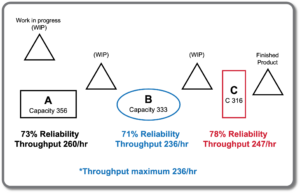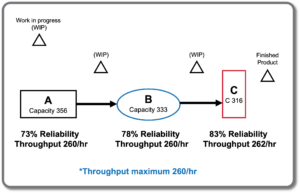Lean manufacturing including lean maintenance has long been a concept both in the United States and in Europe.
The concept seems to have increased in popularity in the past five years.
So, what is lean maintenance? Simply put, it can be said that the thought process in the lean concept should result in that those things that need to be delivered are manufactured on time with less resources.
That is to say that it doesn’t always have to do with always doing more, that can result in waste, but that things that have been sold should be produced when they need to be delivered.
The thought process and packaging of the concept is good but unfortunately nothing new is learned if you participate in a course or seminar on the subject.
To become lean one must prevent maintenance needs and perform remaining maintenance more effectively. It is a well-documented fact of maintenance management.
If the previously mentioned are implemented, then the production reliability will increase and thus the production costs, including maintenance costs and costs for storage, will decrease.
To become lean all losses in the manufacturing and delivery stages of raw material and delivery to the customers must be eliminated. Here I am going to handle the manufacturing phase.
The biggest losses in maintenance, and thus also the biggest improvement opportunities include:
Manufacturing Reliability
- Loss in quality.
- Stop times.
- Loss in speed.
Partnership between Operations – Maintenance – Engineering
- Reliability and maintenance related design.
- Operator based maintenance.
Elimination of root cause of the problem
- Choose problem to eliminate.
- Eliminate problems.
- Educate and teach.
Storage
- Reduce the store value at the same time as you preserve service level to maintenance.
Integration and application of increased knowledge and skills
- Education and training of crafts people to enable multi craft or multi skills.
- Implementation of flexible work systems.
Over manufacturing
- Make more than what has been sold.
- Manufacture too early.
Over maintenance
- Perform too much and wrong preventive maintenance.
- Perform preventive maintenance before it is needed.
- Do corrective maintenance with higher priority than needed.
Use of new technology
- Less need for maintenance.
- Better maintainability.
- Smart tools and methods.
In the following articles I will discuss the aforementioned areas more in detail. In this article I will start with some fundamental concepts within manufacturing reliability.

Image 1. Basic Reliability mathematics.
It isn’t always obvious where improvements in the manufacturing chain are the most cost effective to implement. Flow of a product is the result of Capacity x Reliability.
At first glance you could believe that C is the bottleneck in the production chain since capacity there is 316 pieces per hour compared to the higher capacity in A (356) and B (333). If you calculate the flow you will find that the bottleneck is at manufacturing stage B. this is compensated and hidden by increasing storage of Work In Progress (WIP) so that it can sometimes seem that throughput is not a problem.
WIP is a big hidden cost for a lot of companies. With low reliability throughput of product in the manufacturing chain it takes a longer time and the costs are increased for the WIP.

Image 2. Reliability Mathematics.
By raising the reliability in step C to 83% the increased throughput is 260 per hour. The WIP is reduced since the manufacturing steps are now balanced. Other solutions include procurement of increased capacity through investing in a parallel machine for C.
This would lead to unnecessary high capacity in step C. Moreover the cost of buying more capacity is at least ten times higher than investing in measures that will increase reliability.
Lean manufacturing’s sub-target is to reduce WIP and speed up the throughput in the manufacturing chain.
Reliability includes quality, time and speed. Lean maintenance has a crucial key role in raising the part of reliability that is affected by the manufacturing equipment. Since the manufacturing process is more and more dependent on atomization, good maintenance becomes more and more important.
Availability or reliability?
Many organizations use availability as a key measurement for manufacturing efficiency, but availability encompasses only the percent of planned time, or available time, that a production process produces. Read this article to learn more about Reliability and Maintenance KPIs you should track.
Availability excludes the quality of that which is produced. To produce something that isn’t up to quality standards are often more expensive then to not produce at all.
To slow down a process because, for example, a part of the production process can’t operate at full speed is also expensive. So we must focus the improvement initiative on all elements of what we call manufacturing reliability. They are quality, time and speed.
Manufacturing reliability can be measured in various ways and, simply put, it is about how much is manufactured at the right quality divided by how much could have been manufactured at the right quality. Or, % Quality x % Time x % Speed.
Overall nothing should be manufactured before it has been sold and is to be delivered.
In many heavy process industries people are still living with the thought process to always produce as much as possible.
In”lean thinking” nothing is produced until it needs to be delivered because it has been sold. A good example is computer companies.
When you order a computer from, for example, Dell, the order is sent to production planning that begins to assemble the computer in order to deliver it within a few days to you.
Instead of having all types of computers in storage, the whole company’s economy including cash flow, liquidity, costs for materials and material storage and capital costs are affected.
To have a lean production process and be able to produce things”just in time” is impossible if the production reliability is very high.
With a raised automation level the company becomes more and more dependant on reliable equipment, in other words maintenance. Reliable production equipment is the most important result a maintenance operation generates and it can be seen as the maintenance department’s income generating section.
To achieve lean maintenance it is important that you know where the greatest could become
What is the worth of reducing the difference between how good you are and how good you could be?
In a market situation where you can sell everything you can produce the equation is simple.
In certain industries the sales price of what you are selling can drastically fluctuate. Then you can base your calculations on the average sales price and variable cost over, for example, five years.
| Average sales price five years | £ 510/unit |
| Average variable cost five years | £ 340/unit |
| Benefit per produced, sold and delivered unit | £ 170/unit |
The value of producing and delivering a sold unit is £ 170. If you currently produce and deliver 25,000 units per year and your production reliability is 88% but it is possible to reach 94% then the value of increasing production reliability is 6%.
1500 units x 170 = 255,000 £ per year.
The next question you should ask is if you can reach even better results through focusing on lowering maintenance costs.
Could it be more beneficial to lower maintenance costs if you can maintain Manufacturing reliability at 88%?
The answer seems to be obvious but it isn’t that unusual those economists are so focused on lowering visible costs that they don’t see the invisible, large opportunities that are concealed in increased production or faster throughput of product.
A concept worth repeating many times is that if you increase manufacturing reliability then manufacturing costs, including maintenance costs will decrease.
If you can’t sell the increased volume that you can reach with the higher manufacturing reliability, then the savings most often lie in more reliable and faster delivery of goods sold, less energy expenditure, much better safety and less overtime.
Read part 2, part 3, and part 4





